From the Trenches
The Lead Standard
By DANIEL WEISS
Thursday, October 10, 2019
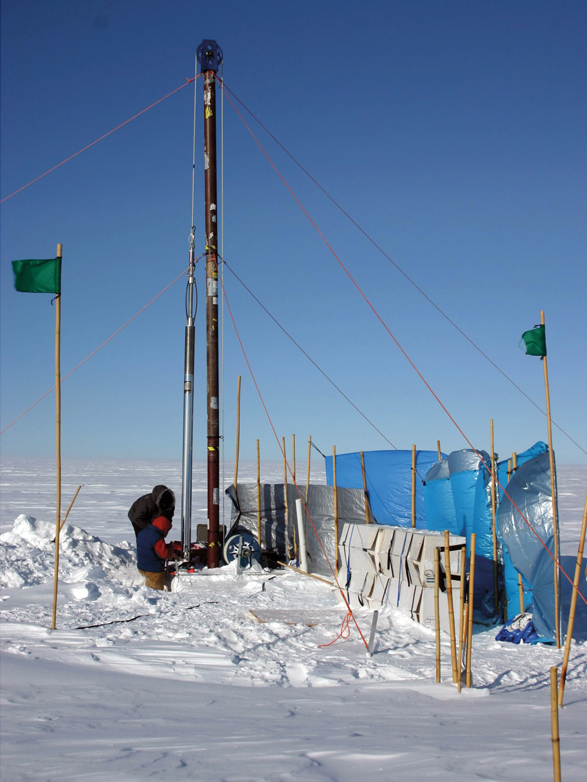 Given that lead is a by-product of silver mining and smelting, historical levels of lead pollution can serve as a proxy for tracking economic growth and decline across the ages. A team of researchers recently studied lead levels dating back to A.D. 500 in 13 Arctic ice cores—12 in Greenland and one in the Russian Arctic. Their results reveal periods during which pollution levels increased or decreased, corresponding to historical records of new mining activity, technological development, or population growth, or outbreaks of disease, war, or famine.
Given that lead is a by-product of silver mining and smelting, historical levels of lead pollution can serve as a proxy for tracking economic growth and decline across the ages. A team of researchers recently studied lead levels dating back to A.D. 500 in 13 Arctic ice cores—12 in Greenland and one in the Russian Arctic. Their results reveal periods during which pollution levels increased or decreased, corresponding to historical records of new mining activity, technological development, or population growth, or outbreaks of disease, war, or famine.
For instance, lead levels shot up in the late eighth century, coinciding with the operation of a mine and mint at Melle in western France under Charlemagne (r. A.D. 768–814), founder of the Carolingian Empire, which controlled much of western and central Europe. During his reign, for the first time, lead levels in the ice cores exceeded those recorded at the height of the Roman Empire—some 600 to 800 years earlier—though they dropped after his death in A.D. 814. Later, in the mid-fourteenth century, pollution levels plummeted with the arrival of the Black Death and remained low in some of the cores for a full century. “That’s a very longterm impact,” says Joe McConnell of the Desert Research Institute, “but if you kill off a third of the population of Europe, you can imagine that it would take a few generations to get back to the same level of demand and workforce.”
Worlds Apart
By MARLEY BROWN
Thursday, October 10, 2019
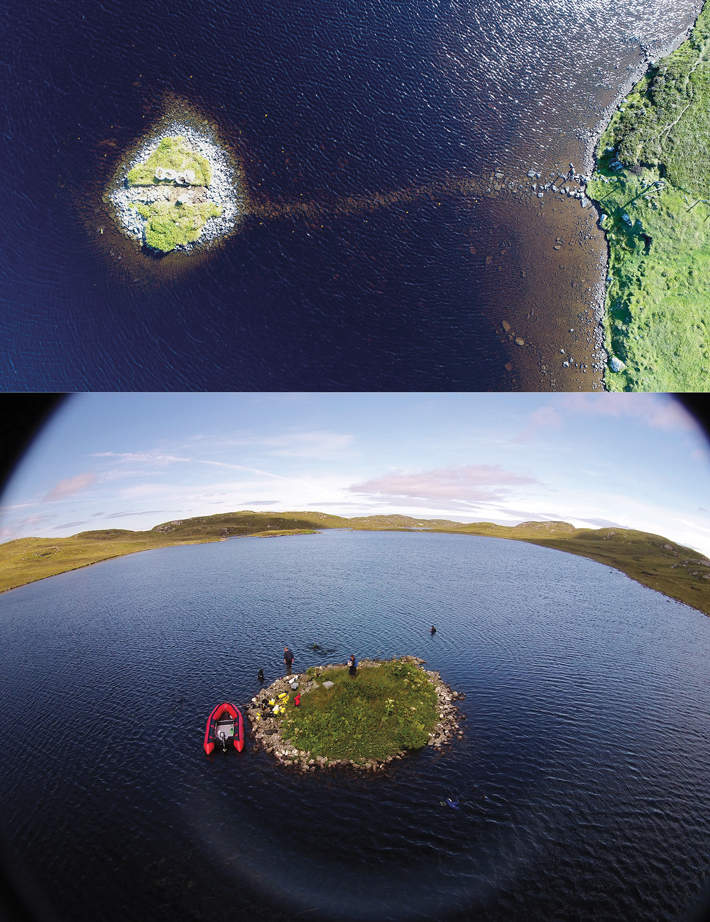 Artificial islets called crannogs, which dot the cold loch waters of Scotland and Ireland, were once thought to have been used as defensive fortifications from the Iron Age through the seventeenth century. But both the constructions’ purpose and when they were first built are being questioned. After former Royal Navy diver Chris Murray discovered Neolithic ceramics while exploring crannogs in bodies of water on Scotland’s Isle of Lewis, archaeologists Duncan Garrow of the University of Reading and Fraser Sturt of the University of Southampton conducted underwater surveys at four crannog sites. They found that the crannogs were occupied starting sometime in the middle of the fourth millennium B.C.
Artificial islets called crannogs, which dot the cold loch waters of Scotland and Ireland, were once thought to have been used as defensive fortifications from the Iron Age through the seventeenth century. But both the constructions’ purpose and when they were first built are being questioned. After former Royal Navy diver Chris Murray discovered Neolithic ceramics while exploring crannogs in bodies of water on Scotland’s Isle of Lewis, archaeologists Duncan Garrow of the University of Reading and Fraser Sturt of the University of Southampton conducted underwater surveys at four crannog sites. They found that the crannogs were occupied starting sometime in the middle of the fourth millennium B.C.
Garrow thinks that other crannogs across Scotland and Ireland may also turn out to be older than previously believed. “We had thought that the Neolithic period was marked by settlements with houses and hearths and then tombs, and subsequently stone monuments,” he says. “In a way, these artificial islets are something in between.” Garrow suggests that while some of the crannogs were likely inhabited, others were too small to have accommodated dwellings. These may have been used as ritual spaces intended to exist apart from the everyday world.
Provincial Pen Pal
By BENJAMIN LEONARD
Thursday, October 10, 2019
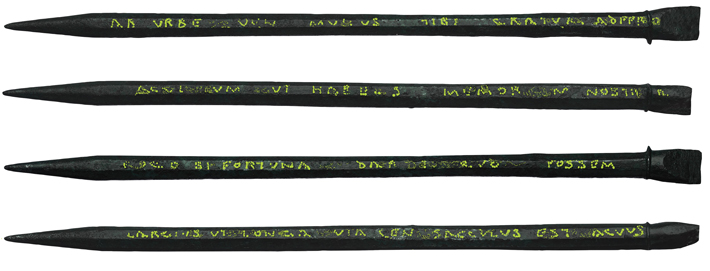 Long before pressed pennies and postcards, a resident of Londinium (Roman London) received a witty souvenir from the empire’s capital. An iron stylus—a writing implement used to press letters into wax or clay tablets—dating to about A.D. 70, unearthed from a trash dump along a lost tributary of the Thames, bears a personal message in Latin etched along its sides:
Long before pressed pennies and postcards, a resident of Londinium (Roman London) received a witty souvenir from the empire’s capital. An iron stylus—a writing implement used to press letters into wax or clay tablets—dating to about A.D. 70, unearthed from a trash dump along a lost tributary of the Thames, bears a personal message in Latin etched along its sides:
I have come from the City. I bring you a welcome gift
with a sharp point that you may remember me.
I ask, if fortune allowed, that I might be able (to give)
as generously as the way is long (and) as my purse is empty.
In the decades following the conquest of Britain, Londinium experienced an influx of Roman soldiers and merchants, who brought with them goods from all across the Roman world. “This stylus is a clear demonstration of a personal connection between someone in Londinium, which lay close to the edge of the empire, and someone who had been to Rome, which lay at its heart,” says Museum of London Archaeology senior finds specialist Michael Marshall. “The gift’s recipient, or a friend or family member, may have been the owner of this stylus.”
Megalithic Mystery
By BENJAMIN LEONARD
Thursday, October 10, 2019
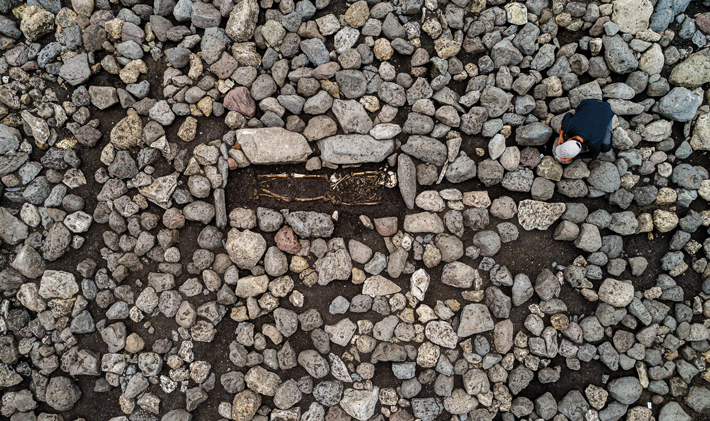
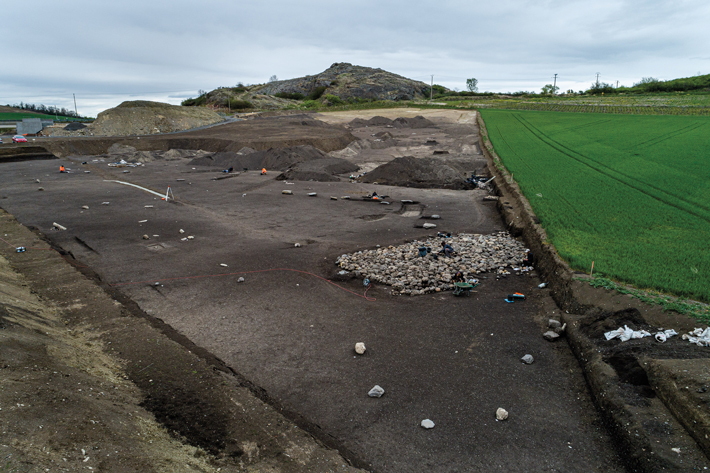 Roadwork at Veyre-Monton in central France has revealed the first known megalithic site in the region. There, archaeologists from France’s National Institute of Preventive Archaeological Research (INRAP) have uncovered evidence of cult activity spanning thousands of years, from the Neolithic period through the Bronze Age. They identified 30 menhirs, or monoliths, arranged from largest to smallest in a 500-foot-long line oriented precisely north to south. Most of the menhirs are made of local basalt and undecorated, but a single limestone example was sculpted to resemble a person, with two small breasts and an engraved chevron that might depict forearms.
Roadwork at Veyre-Monton in central France has revealed the first known megalithic site in the region. There, archaeologists from France’s National Institute of Preventive Archaeological Research (INRAP) have uncovered evidence of cult activity spanning thousands of years, from the Neolithic period through the Bronze Age. They identified 30 menhirs, or monoliths, arranged from largest to smallest in a 500-foot-long line oriented precisely north to south. Most of the menhirs are made of local basalt and undecorated, but a single limestone example was sculpted to resemble a person, with two small breasts and an engraved chevron that might depict forearms.
At some point all the menhirs were intentionally buried, as was an adjacent four-sided stone cairn, measuring 46 feet long and 21 feet wide, that surrounded the tomb of a tall man. Despite the site’s long use, the motivations behind the monuments’ removal from the landscape are unknown. “It’s very tempting to interpret this as the result of a change in beliefs,” says INRAP archaeologist Ivy Thomson, “but it may also be linked to the disgrace of the community in control of the site, or even something more trivial.”
Melting Season
By BENJAMIN LEONARD
Thursday, October 10, 2019
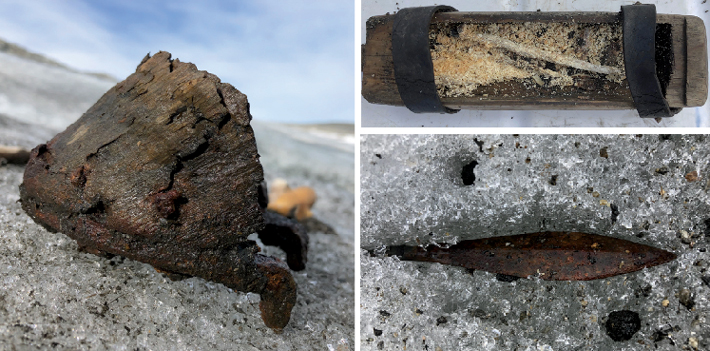 Humans and animals have traversed the icy landscape of Norway’s Jotunheimen Mountains for thousands of years. Now, melting ice patches at a site in northern Oppland County are exposing evidence of these often-treacherous crossings. A team of archaeologists led by Espen Finstad of the Secrets of the Ice Project has recovered hundreds of well-preserved artifacts scattered across the high mountain pass, including a Viking-period arrowhead, a horse’s snowshoe, and a wooden tinderbox with leather straps containing a stick and fragments of resin-filled wood. “We believe we are seeing a long series of losses and discards,” says project codirector Lars Pilø, who remarks that none of the finds seem to be associated with any of the others, despite the fact that most appear to date to the Viking Age and medieval period. Not everyone who ventured into the mountains survived the harsh conditions, however. The team found a packhorse—its ribcage and shod hooves still partially intact—that met its chilly end centuries ago.
Humans and animals have traversed the icy landscape of Norway’s Jotunheimen Mountains for thousands of years. Now, melting ice patches at a site in northern Oppland County are exposing evidence of these often-treacherous crossings. A team of archaeologists led by Espen Finstad of the Secrets of the Ice Project has recovered hundreds of well-preserved artifacts scattered across the high mountain pass, including a Viking-period arrowhead, a horse’s snowshoe, and a wooden tinderbox with leather straps containing a stick and fragments of resin-filled wood. “We believe we are seeing a long series of losses and discards,” says project codirector Lars Pilø, who remarks that none of the finds seem to be associated with any of the others, despite the fact that most appear to date to the Viking Age and medieval period. Not everyone who ventured into the mountains survived the harsh conditions, however. The team found a packhorse—its ribcage and shod hooves still partially intact—that met its chilly end centuries ago.
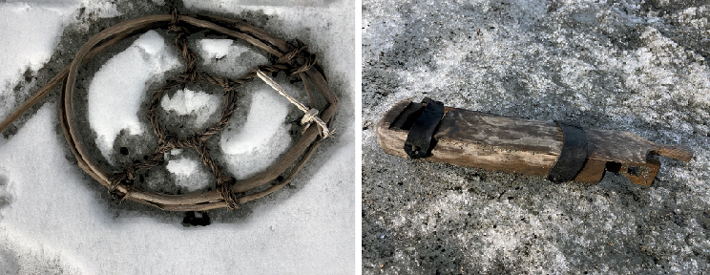
Advertisement
Advertisement
IN THIS ISSUE
From the Trenches
Proof Positive
Off the Grid
The Wrath of the Hittites
Melting Season
Provincial Pen Pal
Megalithic Mystery
Worlds Apart
The Lead Standard
Egypt's Temple Town
Æthelburga's Local Church
Down by the River
Rise of the Greek Crane
Jetting Across the British Isles
World Roundup
Island hopping to Australia, Dead Sea Scroll survival, Roman social security, and the village Canada forgot
Artifact
Another face in the crowd
Advertisement

Recent Issues
-
 May/June 2024
May/June 2024
-
 March/April 2024
March/April 2024
-
 January/February 2024
January/February 2024
-
 November/December 2023
November/December 2023
-
 September/October 2023
September/October 2023
-
 July/August 2023
July/August 2023
-
 May/June 2023
May/June 2023
-
 March/April 2023
March/April 2023
-
 January/February 2023
January/February 2023
-
 November/December 2022
November/December 2022
-
 September/October 2022
September/October 2022
-
 July/August 2022
July/August 2022
-
 May/June 2022
May/June 2022
-
 March/April 2022
March/April 2022
-
 January/February 2022
January/February 2022
-
 November/December 2021
November/December 2021
-
 September/October 2021
September/October 2021
-
 July/August 2021
July/August 2021
-
 May/June 2021
May/June 2021
-
 March/April 2021
March/April 2021
-
 January/February 2021
January/February 2021
-
 November/December 2020
November/December 2020
-
 September/October 2020
September/October 2020
-
 July/August 2020
July/August 2020
-
 May/June 2020
May/June 2020
-
 March/April 2020
March/April 2020
-
 January/February 2020
January/February 2020
-
 November/December 2019
November/December 2019
-
 September/October 2019
September/October 2019
-
 July/August 2019
July/August 2019
-
 May/June 2019
May/June 2019
-
 March/April 2019
March/April 2019
-
 January/February 2019
January/February 2019
-
 November/December 2018
November/December 2018
-
 September/October 2018
September/October 2018
-
 July/August 2018
July/August 2018
-
 May/June 2018
May/June 2018
-
 March/April 2018
March/April 2018
-
 January/February 2018
January/February 2018
-
 November/December 2017
November/December 2017
-
 September/October 2017
September/October 2017
-
 July/August 2017
July/August 2017
-
 May/June 2017
May/June 2017
-
 March/April 2017
March/April 2017
-
 January/February 2017
January/February 2017
-
 November/December 2016
November/December 2016
-
 September/October 2016
September/October 2016
-
 July/August 2016
July/August 2016
-
 May/June 2016
May/June 2016
-
 March/April 2016
March/April 2016
-
 January/February 2016
January/February 2016
-
 November/December 2015
November/December 2015
-
 September/October 2015
September/October 2015
-
 July/August 2015
July/August 2015
-
 May/June 2015
May/June 2015
-
 March/April 2015
March/April 2015
-
 January/February 2015
January/February 2015
-
 November/December 2014
November/December 2014
-
 September/October 2014
September/October 2014
-
 July/August 2014
July/August 2014
-
 May/June 2014
May/June 2014
-
 March/April 2014
March/April 2014
-
 January/February 2014
January/February 2014
-
 November/December 2013
November/December 2013
-
 September/October 2013
September/October 2013
-
 July/August 2013
July/August 2013
-
 May/June 2013
May/June 2013
-
 March/April 2013
March/April 2013
-
 January/February 2013
January/February 2013
-
 November/December 2012
November/December 2012
-
 September/October 2012
September/October 2012
-
 July/August 2012
July/August 2012
-
 May/June 2012
May/June 2012
-
 March/April 2012
March/April 2012
-
 January/February 2012
January/February 2012
-
 November/December 2011
November/December 2011
-
 September/October 2011
September/October 2011
-
 July/August 2011
July/August 2011
-
 May/June 2011
May/June 2011
-
 March/April 2011
March/April 2011
-
 January/February 2011
January/February 2011
Advertisement






